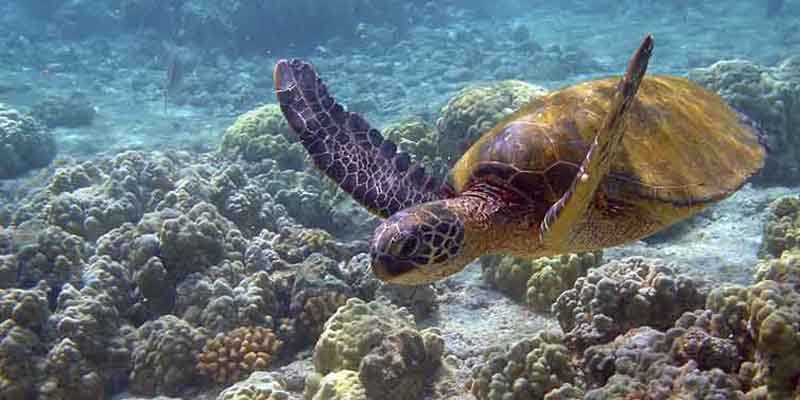June 29, 2012 was a very exciting day on Castaway Island, Fiji.
We celebrated with our friends from the Mamanuca Environment Society the completion of their turtle project by releasing 3 turtles from the shores of Castaway back into their natural habitat.
The release was after years of in-depth study into turtles in an effort to ensure their survival in Fiji. The study included research into their habitats, breeding, handling and best practice implemention for their conservation.
Turtles have long been a ‘delicacy’ for many local Fijians. It is only after MES Fiji’s efforts has the threat to their survival been highlighted and addressed.
May all turtles swim in our beautiful waters for years to come. Vinaka!
A turtle’s journey…
Adi Mamanuca, a female hawksbill turtle, travelled over 600 kilometres in 2008, from her nesting place in the Mamanuca Islands in the west of Fiji, around to Gau Island in the east. She had been tagged and released as part of the Mamanuca Sea Turtle Conservation Project, an innovative collaboration between communities, environmental groups and resorts in the Mamanuca group of islands in Fiji. The project is implemented by the United Nations Development Programme and supported by the GEF Small Grants Programme.
The numbers of marine turtles have fallen sharply worldwide, and all five species found in the Pacific are now classified as “Endangered” or “Critically Endangered.” In addition to being a nesting ground for hawksbill and green turtles, Fiji is a key feeding area, with around 60% of all turtles tagged in the Pacific sighted in Fijian waters.
Information expo during the launch of the Pacific’s first ever best practice guidelines for turtle conservation for resort operators and village communities in the region.
The Mamanuca Island group with its picture postcard beaches is a major area for tourism. It is also one of the main nesting sites for hawksbill turtles, and more than 20 of the islands have nests during the nesting season from October to April. Resort operators are keenly aware that the draw-card of beautiful beaches and teeming ocean life are ecosystems in a delicate balance, and that endangerment or extinction of turtle species will threaten that balance. Geoffrey Shaw, the chair of the Mamanuca Environment Society, and Managing Director of Castaway Island Resort said that biodiversity conservation and the tourism sector are closely linked in the Pacific, “in a business sense, we need to maintain the environment, not just in an environmental sense. We will have nothing to sell if we don’t.”
For the traditional custodians of the Mamanuca Islands and surrounds, marine turtles were regarded as a chiefly dish, and harvested for special ceremonies. The importance of protecting turtles has however, become clear to the leaders of the communities of Lawa and Vuda, traditional owners of the Mamanuca Islands, and these communities are now at the forefront of turtle conservation efforts.
The Mamanuca Turtle Conservation Project brings together village communities, traditional owners, and resort operators to promote and maintain sustainable practices around marine turtles within resorts and communities in the Mamanuca Islands. With the support of a grant from the GEF Small Grants Programme, the Mamanuca Environment Society is working to promote community and resort education and awareness around turtle conservation, and documenting its findings to share with other island communities in the Pacific.
Three more turtles were released as part of turtle conservation in the Mamanucas.
The project achieved a key milestone in June 2012, releasing the first ever Pacific best practice guidelines for turtle conservation for resort operators and village communities in the region. In addition, a comprehensive Community-Based Management Plan, and a biological report were also issued. The three documents together represent the collaborative work of the Mamanuca Environment Society, the traditional owners of the Mamanuca Islands, and resort operators.
Project Manager Betani Salusalu said that the best practice guidelines provide policies and practices that can be adopted by organizations and government to sustain turtle conservation around the Fiji islands and the Pacific. “They are a model for the Fiji Islands to take turtle conservation to the next level. This is not only for Fiji, it is for the Pacific,” he said.
The opportunity to engage with the private sector, grassroots community groups and traditional custodians of the islands in a conservation effort was a major reason for this project’s inception. Katarina Atalifo-Malo, GEF Small Grants Programme Sub-Regional Coordinator noted that a key success was the integration of science and traditional knowledge. “The Small Grants Programme will continue to urge resort owners and other community based organizations to take an active role in conservation and to continue to empower communities in the process,” she said.
As the best practice guidelines were launched, drawing congratulations from communities, government, environmentalists and resort owners, three more turtles were released into the water, another step in the journey towards conservation in the Mamanucas.


